After putting over 300 rounds through the Remington 1911 R1 Hunter FDE 10MM pistol, I recommend this semi-automatic as a top firearms investment for at least two reasons.
First, with its six-inch-long stainless-steel barrel and match-grade sights, the R1 Hunter is accurate and powerful and, as the name suggests, a fine choice for handgun hunting.
Second, given the financial and managerial turmoil that has been Remington Arms, it’s possible the world will never see another R1 Hunter 10MM FDE being made. Buy one now, and you may have a collector’s item.
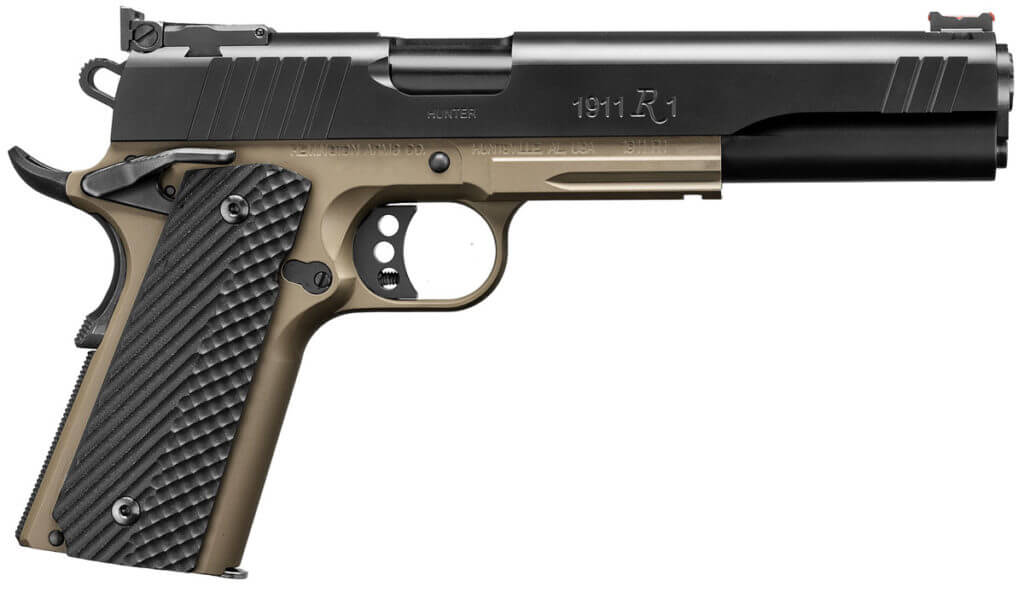
When the gun talk turns to Remington, the focus is usually on the company’s Remington 700 centerfire rifles and the Remington 870 pump-action shotguns. Understandably so, given the literally millions of each purchased by hunters and shooters.
But most gun talk never gets to Remington’s handguns. And that’s too bad. Because despite one flat-out disaster a few years ago (the Remington R51 9mm semi-automatic pistol), Remington has actually been making some pretty damned good 1911’s since 2010 when it launched its R1 line of pistols. And, actually, they also fixed the R51. It is a very accurate and serviceable 9MM, very suitable for concealed carry and home defense.
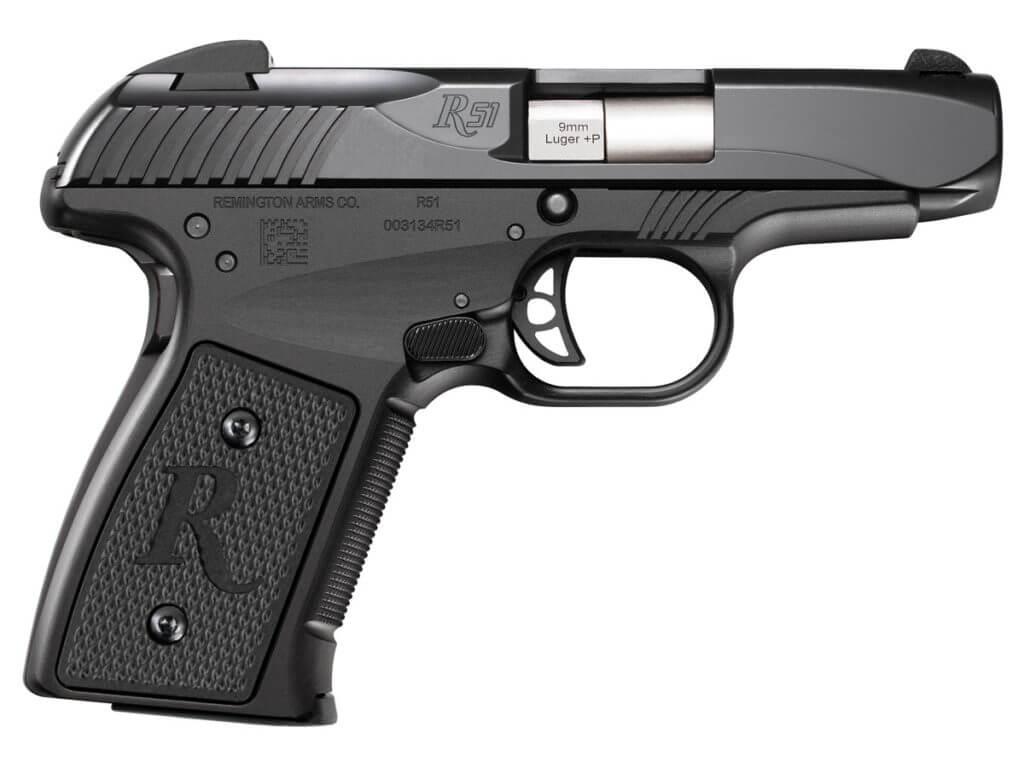
Handguns are nothing new for Remington. Actually, one of Remington’s first handguns was the 1858 revolver and it saw service during the US Civil war. Remington’s answers to the Colt 1873 included the model 1875 and later the model 1890.
Remington UMC manufactured the company’s very first 1911’s during World War One and Remington made more of this workhorse pistol during World War Two. As noted, it re-launched the current 1911 R1 line of 1911’s a decade ago.
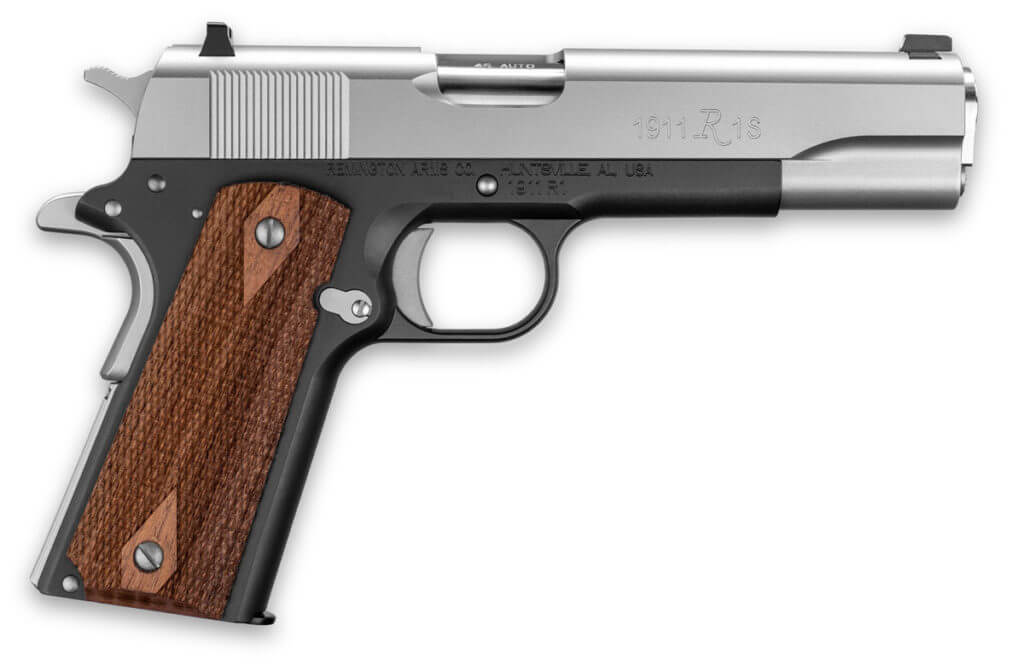
The Remington 1911 R1 Hunter FDE is a single-action semi-automatic sporting a stainless-steel frame and slide, a great trigger, and a long sight radius thanks to the six-inch-long, stainless steel match-quality barrel. It is the “younger brother” of the more established standard R1 Hunter, but unlike bigger bro, this model sports a Flat Dark Earth (FDE) finish on the frame.
The pistol is no lightweight, not at 41 ounces unloaded, which means that loaded with eight rounds in the magazine and one in the chamber, the R1 Hunter is pushing up against the 50-ounce mark. Weight bullet.
That weight and the tactical, high-quality word VZ-1o grips, though, work to make the powerful 10MM AUTO round relatively easy to handle.
Recently, I was visiting the St. Charles Sportsmen’s Club in Elburn, Illinois, and did some handgun training with the Club’s assistant manager Lisa Palazzo.

We shot a couple of different 9MM semi-autos, a 380 compact, and a full-sized 1911 chambered in 45 AUTO, plus the R1 Hunter FDE I brought along. And though she’s a relatively small woman at 5’3”, Palazzo actually did her best shooting that day with the R1 Hunter FDE.
“It looks like it’s going to be a real handful,” she told me afterward about the R1 Hunter. “But it’s really easy and fun to shoot. I haven’t shot a lot of pistols, and I can’t believe some of the hits I made with it!”
Credit the pistol’s weight and balance and first-rate grips for much of the shoot-ability Palazzo found with this pistol.
For my accuracy and function testing with the R1Hunter FDE is used three brands of 10MM ammunition: Honor Defense shooting a 125-grain hollow point frangible bullet; Remington Hog Hammer launching a 155-grain Barnes all-copper XPB bullet; and, Winchester’s Defender Elite loaded with a 180-grain bonded and jacketed hollow point.
At 10 yards and firing offhand, all three brands of ammunition placed multiple five-shot groups at 1.5-inches and under. The best group was with the Honor Defense 10MM loads, which pegged five shots at 1.15-inches—and three of those shots were touching for a .59-inch group.
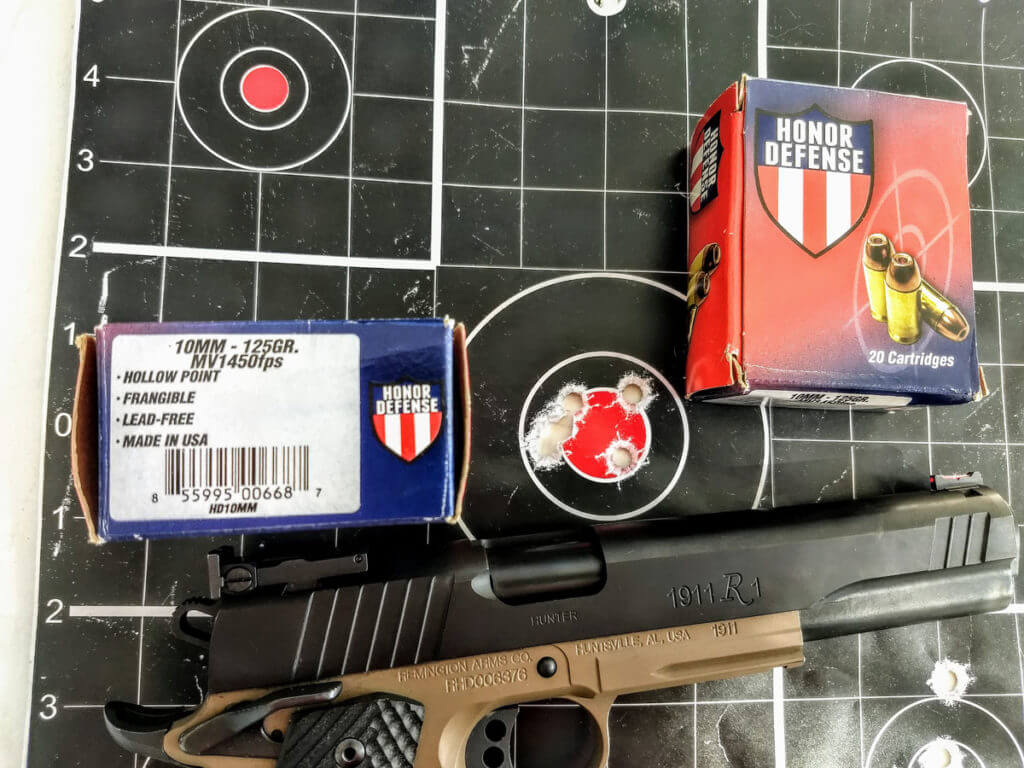
Then, I moved to the 25-yard range and fired the three ammunition brands shooting from a rest. My five shot groups were 3.0-inches and under, with the Hog Hammer scoring the best with a 2.14-inch grouping on a hog hunting target. The Winchester Defender scored a couple of groups right at 2.5-inches.
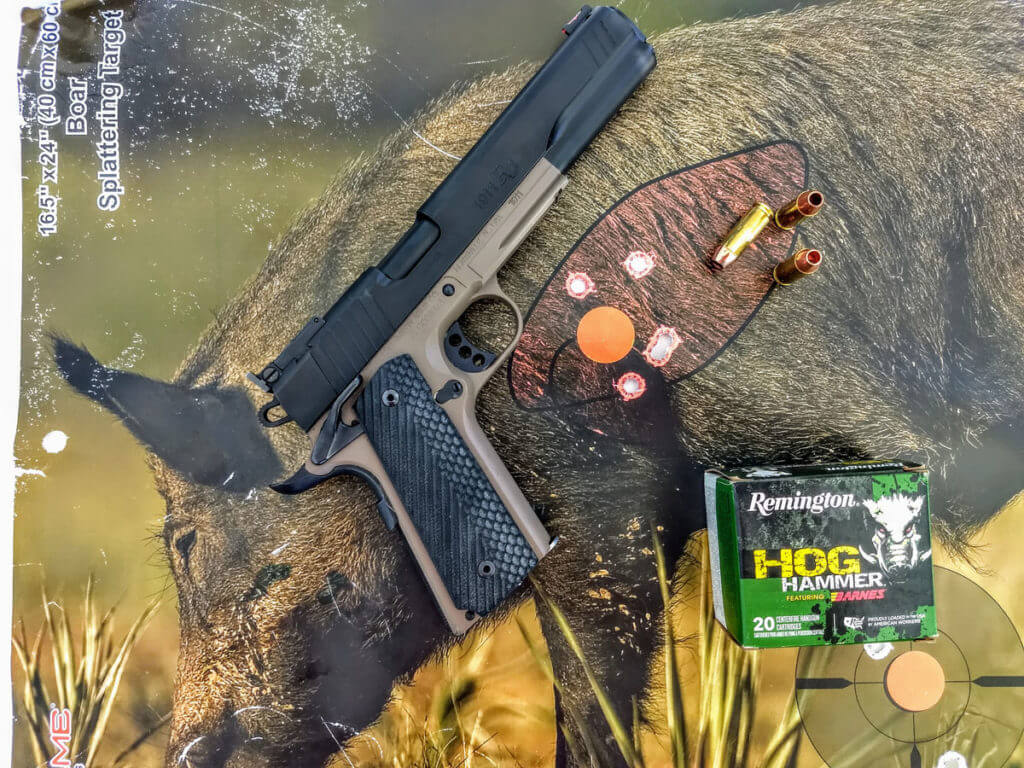
Initially, the pistol was shooting several inches low and to the left at 10 yards. But that was easily fixed as the rear sight on the R1 Hunter FDE is fully adjustable for windage and elevation. Several clicks on each control, done with a small, flat-bladed screwdriver, soon put the pistol on the bullseye. The luminous fiber optic front sight pops nicely and pulled in my eye.
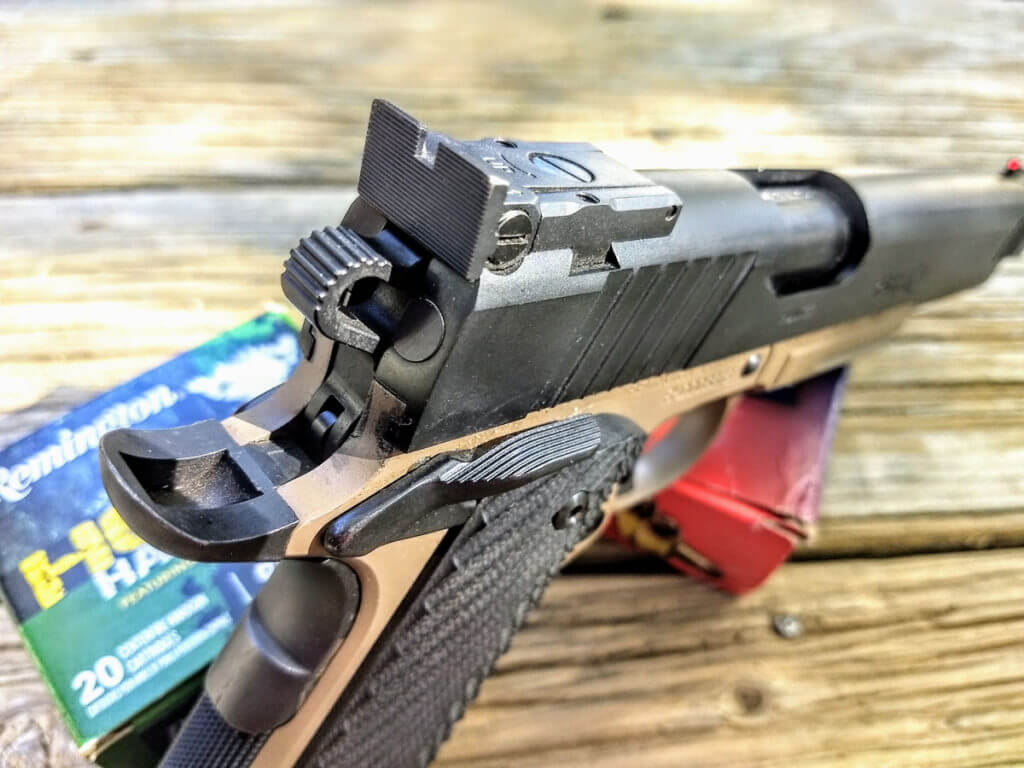
The trigger pulled on the R1 Hunter FDE came in at a crisp 2-pounds, 8-ounces according to my Lyman Digital Trigger Pull Gauge, and it reset very quickly for follow-up shots. The trigger is also adjustable, but I didn’t feel the need to make any changes to mine.
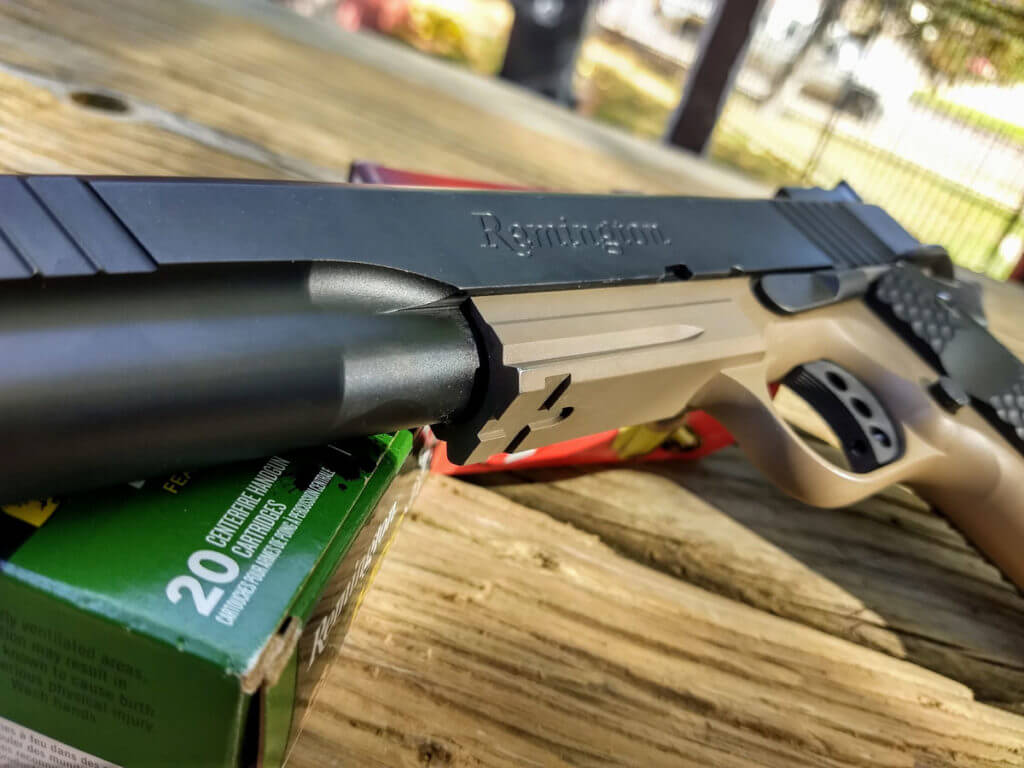
The R1 Hunter FDE sports an ambidextrous butterfly manual safety and an extended beavertail grip safety. It also has a rail under the barrel for attaching lights and lasers or a shooting rest, and the pistol is sold with two, eight-round stainless steel magazines.
The Operator II VZ G10 Grips provided a very firm hold on the pistol, even when pulling off multiple shots fast.
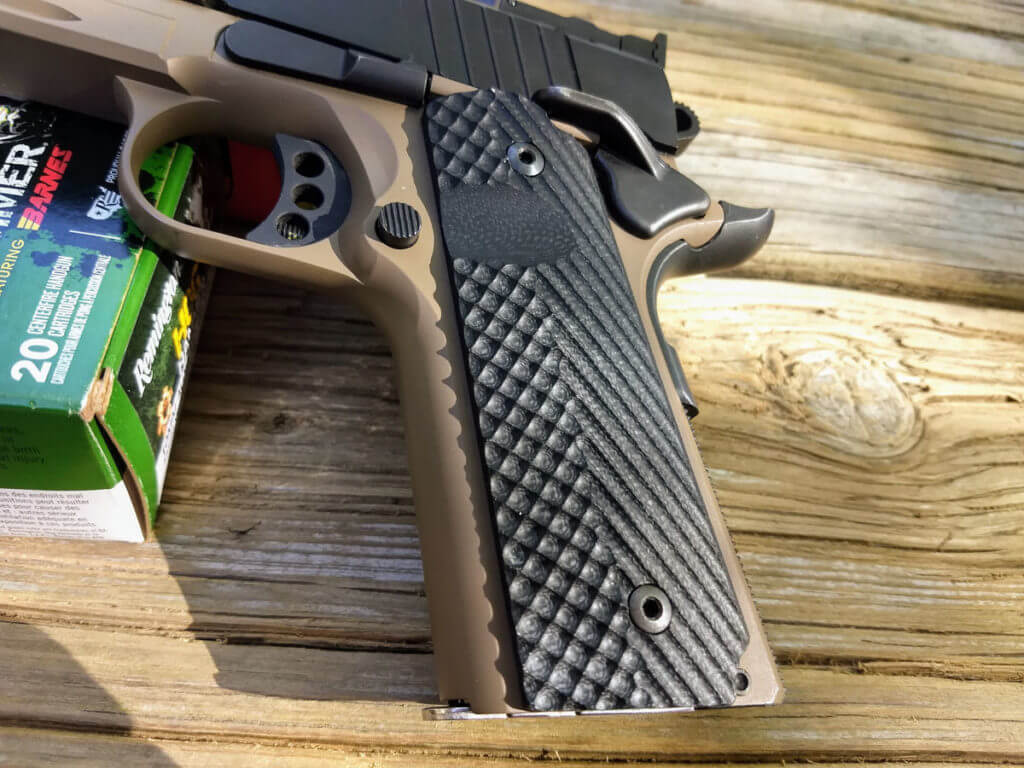
I’ve hunted with my R1 Hunter FDE and the best holster I’ve found for it is the Great Alaskan Chest Holster made by Galco Gunleather. In the field, the Great Alaskan balanced the R1Hunter FDE nicely to the left side of my body, provides a good draw, and keeps the pistol very secure.
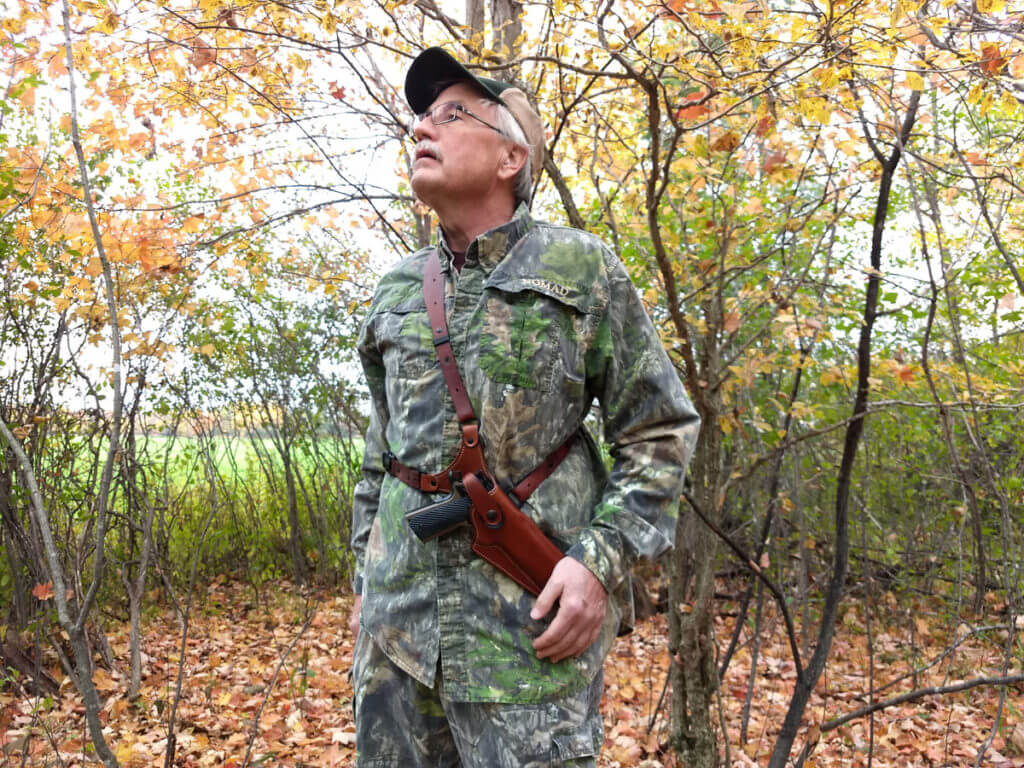
You are supposed to say something negative in a critical sense in a review to show balance and objectivity. Frankly, I am unsure what to say that might be “wrong” or a bit off on the R1 FDE Hunter.
Yes, it’s heavy, but that’s not a surprise with a large pistol sporting a steel frame and slide. The Great Alaskan Chest Holster is a big help there when afield with the Hunter.
Recoil from a 10MM, no matter the weight of the platform, is more significant than the ubiquitous 9MM or even a 45 AUTO. But, again, that comes with the caliber and territory.
Now, it does list for over $1,300, and that isn’t anywhere close to inexpensive. But, A), I can’t tell people what is too expensive for their incomes and tastes; and, B) as long as you don’t hurl this handgun down a rocky-strewn gorge, you should be able to pass it down to your grandchildren. Something I doubt you can say about the $300 striker-fired pistols available today.
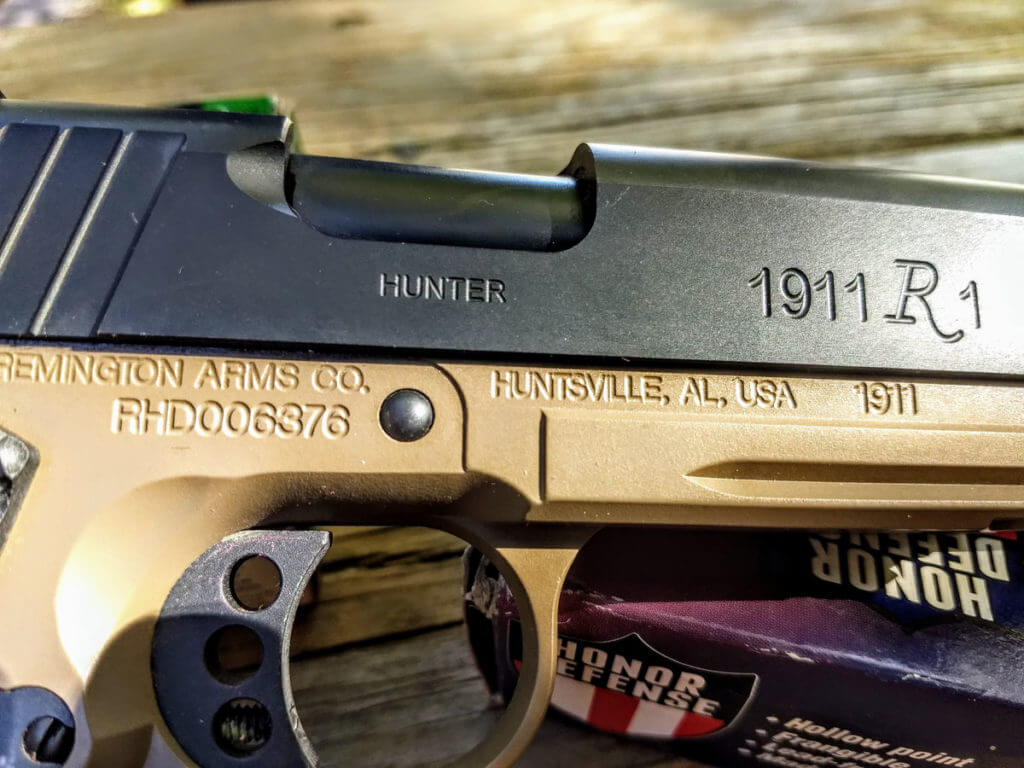
As to possible collector value?
The Remington Outdoor Company or ROC went into bankruptcy this past summer. The various ROC brands–including Bushmaster, DPMS, Marlin, and Remington Arms proper–were sold off to the highest bidders, with the sales recently approved by a federal bankruptcy judge in Alabama in September 2020. Remington Arms now belongs to the Round Hill Group and investment group.
Are handguns, including the R1Hunter FDE, in Round Hill Group’s plans? Even if that is the case, will future R1 Hunters function and look at all like the current R1 Hunter FDE?
No one knows. The Round Hill Group could start turning out new and essentially the same R1 Hunter FDE’s in 2021, could take a year or longer to get out these handguns, or could abandon handguns or this particular model altogether.
Remington handguns were manufactured at ROC’s facility in Huntsville, Alabama. Media and internal sources tell me that various machinery was removed from Huntsville, including some used for firearms manufacture. Whether or not Huntsville will see future Remington production is anyone’s guess.
So, a “Hunter” from “Huntsville” could be a rather unique pistol.
Whatever happens, there’s a decent chance any original R1 Hunter FDE could have collector value one day.
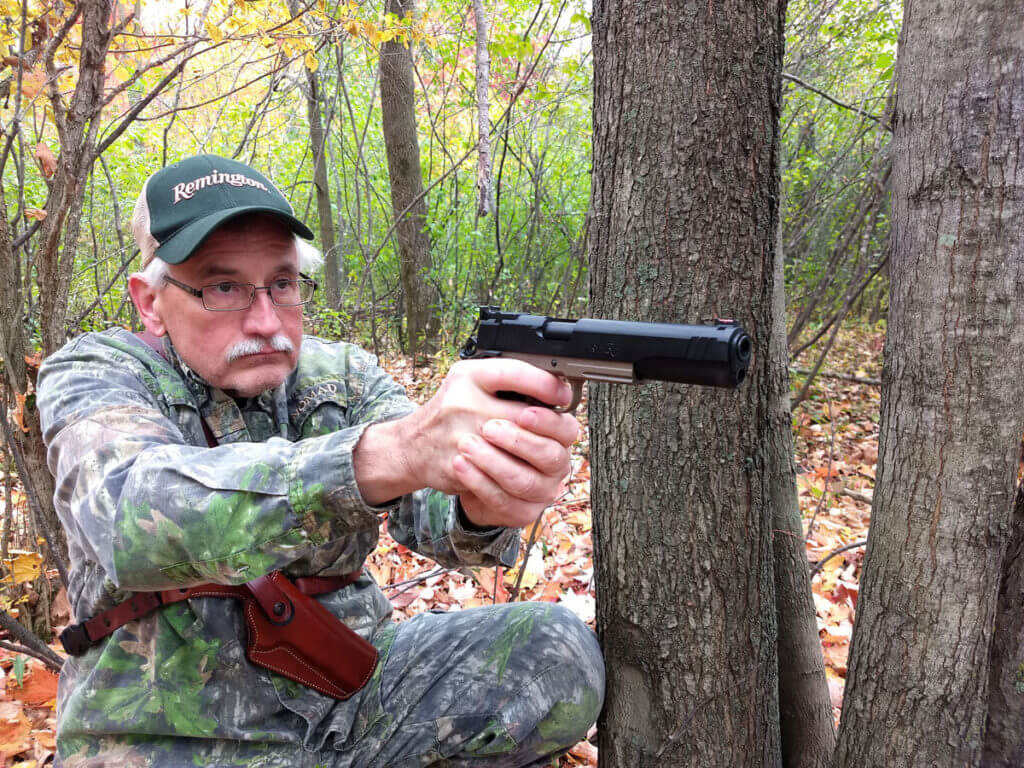
Not that mine will. It’s already been on two hunts and will be on many more over the next several years, and with the banging around my handguns get afield and during practice sessions, my R1 Hunter FDE will likely have too many dings and wear to interest a collector.
And that’s okay. I am a hunter and a shooter, after all, not a collector. And the 1911 Hunter 10MM FDE is really made for the shooter and hunter who likes the power and versatility of the 10MM AUTO round.
SPECS: Remington 1911 R1 Hunter FDE
Caliber: 10MM AUTO
Action: Semi-Auto
Frame: Stainless Steel
Slide: Stainless Steel
Barrel: 6”, Stainless Steel
Twist Rate: 1:16
Sights: Adjustable match grade rear, fiber optic front
Trigger: Single Action, Skeletonized, Adjustable
Finish: Flat Dark Earth, PVD finish
Length: 9.5”
Overall Height: 5.75”
Weight: 41 Oz.
Capacity: 8+1
Misc.: Under-barrel rail, Operator II VZ G10 Grips, front and rear slide serrations, sold with 2 8-round stainless magazines.
MSRP: $1,340.00.


Just curious, were the buyers American or out of country?
Remington’s R series long slide 1911 only began when they bought out Para Ordnance, the early models had Para on the fully adjustable rear sights and match grade barrels which are unbelievably accurate. I own three of them that are all 6 inch models 9mm, 10mm and a 45 acp. Do not overlook the Para’s.
I’ve had the pleasure of owning & hunting with my Wilson Combat Elite 10 MM for over 3 years now and I can tell you that the .45 can’t hold a candle to the 10 MM for hunting…Period! No if’s and’s or but’s…………
“Intentionally Hunting Medium sized Game with Semi Automatic Handguns”
…a niche market for sure.
All good ammo is expensive now, so the fact that 10mm is a little more is not the best measure of its worthiness.
Ironically Buffalo Bore was always super expensive, so if that’s what you usually shoot you are accustomed the paying a lot more per round…
It is damn fine ammo.
And the owner of Buffalo Bore is the absolute expert on big bore hunting.
Unlike in rifles, the smart caliber choices for an often used, versatile, semi-auto handgun are limited.
Basically, .45ACP, .40 S&W and 10mm…..357 Sig and .50 GI are great too, but guns and ammo are a bit hard to find for both of those.
And the former is a bit light for anything bigger than a coyote.
I feel that the .45 ACP is superior in the 1911 format.
But the 10mm is also good and feeds just fine.
I think 10mm is better in the Glock.
I have both and love both
.
What is more true is that if you want to screw up a 1911 chamber it in 9mm.
We’ve seen 9mm 1911’s even from Kimber, who usually make great pistols, that tend to jam.
1911 is best in .45 ACP and its variants….you can convert to +P or .45 Super in about 5 minutes.
Or get a .460 conversion if that .45 Super doesn’t drop ‘em or you want more range.
And if you want more killing power get a .50 GI from Guncrafters Industries, I have one and it’s my favorite pistol.
1911’s like the bigger bores, I think we can agree on that.
There’s something very natural about that pistol in that caliber.
Glock (and it’s variants) are good in all calibers, I don’t like it as much in .45 as I do in 9mm and 10mm, but that has nothing to do with anything the Glock does wrong.
It’s just this, when I think 1911 I think .45 ACP…(or .50 GI)
My 1911’s shoots great, they are .45 ACP and .50 GI.
I love my 1911’s
I would not buy another 1911, one that I might not love, let alone a Remington.
Especially one in 10mm, just so I could shoot Hogs with a 1911.
I already have 10mm Glocks, and I think they are awesome for their purpose.
With Semi-Autos it’s more about the Gun than the Ammo.
They are all good for target.
They are all good for personal defense….(concealed carry is a different topic altogether, that’s where the 9mm is king)
And they are all good for EDC.
They are all good,
Unless you are hunting or carrying for woods defense.
Here the shortcomings of the .45 ACP with regular Regular Ammo become apparent.
I think you have to give the 10mm the slight advantage here (unless you go 45+P or 45 Super)
Stock Ammo in 10mm shoots flatter and has better SD.
On Pigs and Bears penetration is the name of the game.
I don’t intentionally hunt with my semi-autos. I carry them in the woods “just in case”.
I tend to camp away from roads and such 1-3 nights depending on my quarry.
My handgun is a backup to my Rifle or Shotgun.
Here in CA where we have no Grizzlies.
I usually carry a 9mm subcompact or a .38 +P revolver.
With modern penetrator ammo both of these are fine for fending off Black Bears and Lions or popping a coyote or raccoon that might be annoying me.
When I’m hunting each year in Wyoming and Idaho it’s a different matter….10mm Glock with a Streamlight and a high cap magazine.
Wolves and Grizzlies are bigger and meaner than Black Bears and Lions.
This year I’m heading to Alaska to hunt Moose and Caribou….
.50 GI with Penetrator Ammo and Streamlight.
If I were forced to hunt with a sidearm I’d go for a .41 Mag, .44 Mag or something even bigger in a heavy revolver.
The author is right though, 10mm, with factory ammo in factory guns is the way to go for hunting.
It’s fine for pigs which are plentiful, invasive and not generally dangerous.
If I had a handgun only tag (is that even a thing?) for a more valuable species I wouldn’t risk it on a stock semi auto….
But if that’s your thing,
10mm is probably the ticket.
Too true about chambering a 1911 in 9mm too. It has to do with the overall cartridge lengths – the 9mm and the .40 are about a sixth of an inch shorter than the overall length of the .45 ACP (which is pretty close to the OAL of 10mm and .38 Super). Most 1911 makers just put a spacer at the back of the mag and that extra sixth of an inch that the slide travels seems to cause some havok with feeding. The best solution I have seen is to scale down the parts for the shorter cartridge length, a lá the Springfield EMP.
I do a lot of hunting and shooting way out in the sticks, places with no cell reception and few staticky radio stations. One place in particular is about a 30 minute drive to the nearest grocery story and about an hour to the nearest place that sells ammo. If the worst happens, if I drive off and forget my ammo or if my ammo gets lost or some such thing, how far will I have to go to get more? I don’t remember seeing 10mm or .38 Super or 6.5 Creedmoor at the nearest places to buy ammo even in days when ammo is readily available, but plenty of 9mm, .45 ACP and .270 WCF.
Those large frame Glocks, the 10mm and the .45 ACP both, they just aren’t made to be held by human hands. Reliable, sure, low maintenance and all (aren’t they dishwasher safe?) but not comfortable to shoot. Even the XD45 is way more comfortable from the combat tupperware offerings.
I have several 1911’s in my collection. Including a Remington R1 Carry Commander, 45ACP, stamped from the NY factory. It has proven reliability, and accuracy, above any of my 1911’s from varying manufacturers. My only changes to the pistol has been Novak tritium night sights and VZ Grips.
you comment; 10mm vs 45… Like my AussieNZ son-in-law says “yeah Nah”
I just went to Buffalo Bore website directly. I compared 10mm Heavy Outdoorsman versus 45 ACP Heavy Outdoorsman. $34 vs $32 and 703 vs 450 energy with similar weight bullets for about the same price for ammo that was in stock.
Btw; only the hottest 45acp w/ 255gr was able to come up to the energy of the weakest 40SW +P. The 40 was $1 less.
R1 ?
Love mine.
Reliable -101%
Accurate- easy to punch out the center of a claybird at 25 steps.
Wish I had gotten a couple.
It is pretty easy to make a decent 1911 but I have every confidence that Remington can screw it up. Remington 1911s have been fairly well made but chambering one in 10mm is a good start. To screwing one up. If you really want to screw up a 1911, chamber it in .40. I get that some people get excited about the Big 10 but any performance advantage over the .45 ACP is far, far outweighed by ammo cost and availability of the .45. A 1911 in .45 is the answer to the question. And it doesn’t matter what the question is. The 10 is a paper tiger.
The R51 was not Remington’s only trash pistol. The RM380 was junk. I saw with my own two eyes the take down pin fall out when the pistol was racked rotated to the side on multiple RM380s. At least a Jennings will stay together.